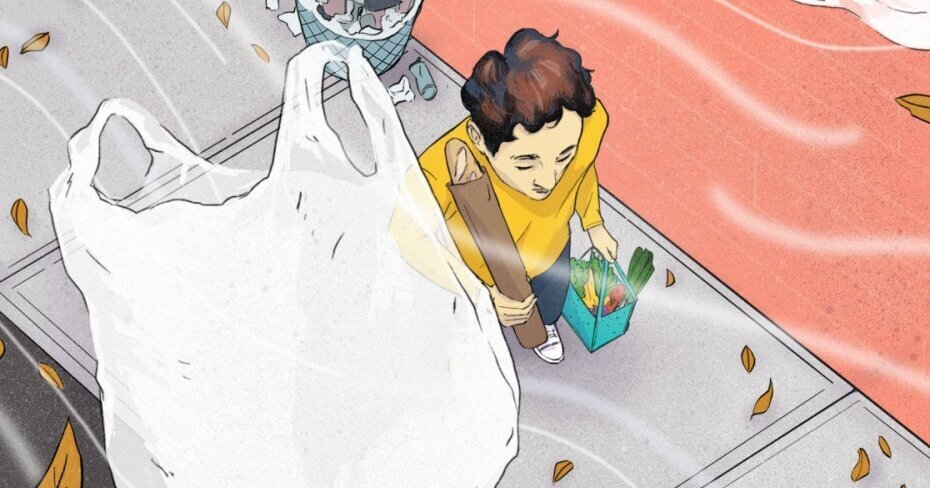Can individual actions stall climate change if not everyone can afford to live sustainably?
By: Jessica Mach on September 16, 2019
There are four subway lines in Montreal, three of which twist and overlap to encircle the city’s core. For Frances (who asked that we not include her last name), a graduate student who lives just east of the city’s Gay Village, this arrangement had always been sufficient enough to meet her day-to-day needs: getting to school downtown, running errands, making it to appointments, and meeting friends in the neighbourhoods in between.
When she had a baby, though, that all changed.
The problem was the elevators. Or rather, it was their absence: out of the Montreal Metro’s 68 stations, only 14 have elevators, according to the Société de transport de Montréal. This is despite the fact that in most stations, the train platforms sit so deep below ground that subway riders need to climb down at least three extended sets of escalators and stairs to reach them. This design presents a clear problem for commuters with limited mobility, including the elderly, small children and many people with walking disabilities. But after her son was born, Frances, who had long used the subway without issue, suddenly found herself more reluctant to use it.
“You have so much stuff [to carry around] with a kid,” she adds. “So you start relying on the car a lot more.”
Frances knew that relying exclusively on a car in a city like Montreal, with its robust public transit system, wasn’t especially great for the environment. For years, Frances has increasingly tried to be mindful of her carbon footprint. She cut down on avocados and bananas, for instance, after learning how much of a strain their production and distribution puts on the environment; she tries to be cognizant about the sourcing of her seafood; she visits brick-and-mortar stores instead of shopping online whenever possible; and after her baby was born, she largely used cloth diapers instead of disposable ones. Although it wasn’t always feasible to choose the most sustainable option, Frances found that these eco-conscious options began to diminish even more when she became a mother: there were so many missing pieces, infrastructurally speaking, that living sustainably often seemed impossible.
Sustainable living is rarely pure or easy if your strategy for achieving it is adjusting your lifestyle within a world that stubbornly refuses to change
Frances isn’t the only one brushing against the limits of her good intentions. According to a 2018 survey by London-based sustainability strategy and creative agency Futerra, a staggering 96% of consumers polled in the U.S. and the UK believe that individual actions, like recycling and “ethical shopping” can help stall the progression of climate change. But nearly half of the respondents (43%) also think that consumer brands make it harder for them to live in ways that are “environmentally friendly” due to excessive packaging, worker exploitation, and ethical options that are priced at a premium.
“Sustainable living,” in other words, is rarely pure or easy if your strategy for achieving it is adjusting your lifestyle within a world that stubbornly refuses to change, too. But when living sustainably is rarely supported by existing infrastructure and actually prohibitive to most people, doesn’t that make it an exclusive privilege? And if only a small number of people can actually attain it, how effective is it as a solution for climate change?
The empowerment factor
Over the past century, environmentalism has generally been split into two camps: one that idealizes nature as a separate, pristine space that needs to be protected from human intrusion; and one that focuses on how environmental hazards, many of which result from human economic development, tend to harm some communities more than others. In recent years, though, discussions about climate change have largely been defined by a sense of doom. “Anecdotally, I've seen it a lot in the past five years,” says Anne Pasek, a post-doctoral fellow in transitions in energy, culture and society at the University of Alberta. “We’re increasingly aware that there’s this very large looming problem on the horizon, which is anthropogenic climate change.”
For many people, this awareness has created a sense of urgency and a desire to act. And in recent years, companies have been adjusting their product offerings and branding to cater to these anxieties.
Reformation, a U.S. women’s clothing store that trademarked the phrase, “Being naked is the #1 most sustainable option — we're #2,” opened its first Canadian brick-and-mortar location in Toronto this summer. In addition to selling dresses and tops that are mostly manufactured in Los Angeles and favoured by influencers, the company also offers shoppers the option to buy carbon offsets and releases a “sustainability report” each quarter.
Everlane, another popular U.S. clothing store that specializes in office friendly basics and brands its retail strategy as “radical transparency,” made a pledge in 2018 to phase out virgin plastics over the next three years; in the fall of that year, the company released a line of outerwear, including cropped sweatshirts and parkas, made out of recycled plastic bottles.
In 2012, Toronto’s Yorkdale Mall opened a “green” food court that gave customers the option to use reusable plates and cutlery, reportedly cutting the amount of daily waste the food court produced from 120 bags to three. The Strategist, a brand under the New York Magazine umbrella that functions like a curated shopping guide, published a list of “the best reusable straws” last summer, with options ranging from US$2 to US$20. It’s become increasingly common for companies to introduce sustainability initiatives, even within their own offices. There are even “zero waste” influencers you can follow on Instagram.
These brands are all selling the same thing: empowerment. Faced with constant news of melting glaciers, rising sea levels and an Amazon in flames, the notion that you could make a tangible difference by making more responsible consumer choices is an appealing one. The limits of this approach, however, quickly become clear when individuals find themselves unable to participate because they can’t afford the sustainably manufactured option, or they live too far away from the stores that carry it, or, in the case of the plastic straw bans that were introduced in multiple cities across Canada and the U.S., they find it physically difficult to do so.
The limits of individual action
Diana has come up against these limits. Last year, while scrolling through Instagram, the Toronto resident (who also asked that her last name not be included in this story) came across the #ZeroWaste hashtag for the first time, which revealed a friendly community that was committed to minimizing its carbon footprint. Diana was quickly intrigued, finding comfort in the community’s lifestyle tips.
She hated, for example, how much packaging ended up cluttering her apartment every time she bought things she needed — shampoo, for instance, or groceries. “I want to lead a lifestyle that doesn’t give me as much anxiety when I’m taking out the recycling and garbage,” she says. “I’m one person and this is all that’s coming out of my house.
For years, Diana carried an extra tote bag with her whenever she went shopping. But under the influence of #NoWaste, she began to branch out. She washed and reused plastic Ziploc bags, and started relying on reusable beeswax food wraps instead of saran wrap. She bought more reusable bags for produce, began freezing chicken bones instead of throwing them out and tried to buy more items, including liquid soap, in bulk. These small acts helped quell Diana’s anxiety about needless waste, but there were times when she would face obstacles that demonstrated how, despite her own efforts, shopping was still largely geared toward disposability.
“If I’m going from my house to get takeout,” she says, “I’ll definitely try to take a container with me,” she says. “But I guess the concern there is [that] a lot of places still don’t take the containers that you bring because of food safety.”
But sustainable living isn’t just about good intentions. It’s also about privilege.
I don’t know if people making choices within a very limited set of options is really going to be able to make a big difference
Frances, for instance, recognizes that many of the environmentally friendly choices she makes are only possible because she has access to the right resources. For about nine months, she and her partner relied on cloth diapers for their son. “I didn’t think it was overly difficult at all,” says Frances. “We had a washer and dryer... we could do the setup right in our bathroom.” If they hadn’t had access to their own equipment, though, laundering cloth diapers every day would not have been realistic. “I can’t imagine trying to do cloth diapers if you had to go to a laundromat."
There were other factors that helped. Her partner’s employer granted him six months of paternity leave, which left him time and energy to care for their son full-time (including laundering his diapers). And Frances herself was able to take parental leave from her graduate program for a year — an option, she points out, that’s not available to all new parents.
At the end of the day, the inaccessibility of so many sustainable practices, to so many people, makes Frances doubtful that her own actions are making any real impact on the environment.
“I don’t know,” she says, “If people making choices within a very limited set of options is really going to be able to make a big difference.”
The power of organization
If that’s true, then why do it at all? Why pit yourself against all of the inconveniences and expenses of sustainable living for no real reason?
Pasek argues that trying to live sustainably does have important merits. They just might not be what you think.
“There’s a psychological dimension to it all,” she says. “If you spend a lot of time, like I do, staring climate change in the face, it can be really quite psychologically paralyzing and depressing. And in the past 10 years there hasn’t been many gains for climate action, so people in the movement are often honestly depressed about the lack of change.”
“A coping mechanism is to control what you can control — even if that isn’t on a scale that’s appropriate to the problem,” she adds. “In activist communities, I see a lot of people who are really invested in their personal consumption habits as the one thing they’ve got locked down, the one area they can see change.”
This is politically useful, Pasek says, because if people feel empowered, they’re more likely to push for policy changes that can effect change on a large scale.
The problem is that climate change is so often framed as something that needs to be solved by individuals, which is what happens in a culture that tends to focus blame on individuals and their habits, instead of the infrastructure built by corporations and government policy. Even when the latter is well-meaning, like when the federal government announced in June that it planned to ban single use plastics by 2021, we still tend to be told that the source of the problem lies in consumer habits, which only shifts our attention away from bigger issues.
“Stuff like straws and single-use plastics are highly visible to us,” says Pasek. “We interact with them everyday and they form a substantive percentage of everything we see going into the garbage. But if you look at larger waste streams, commercial construction waste is actually far more significant. As for ocean plastics, it's actually fishing nets that make the vast majority of that waste stream, not errant straws and bags.”
So, where should we be focusing our energy instead?
“I think the best thing that people can do is join a social movement,” Pasek says. “Collective action is more impactful than personal consumer choices. Moreover, it will connect you to a community of people who share your concerns, so that you feel like you're not alone, which is a really important part of the mental health of living through environmental crisis. And it feels good… [instead of] fighting this personal, impossible battle… you can join a shared community that’s invested in action and we win on much larger scales.”
Diana, who still tries to be conscious of her consumption habits but has lately put less pressure on herself to strictly follow the #ZeroWaste lifestyle, has arrived at a similar conclusion.
“I know... that whatever I do, it’s not going to make enough of an impact — it’s just going to be for myself,” she says. “In the end, what matters for the world… is not what one person is doing, but larger institutional changes.”
Illustration by Taryn Gee.


